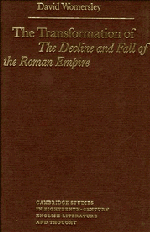Book contents
- Frontmatter
- Contents
- Acknowledgements
- A note on references and quotations
- Introduction
- PART I The historiography milieu
- PART II The Decline and Fall of the Roman Empire
- 3 Introduction
- Volume 1 - 1776
- Gibbon among the philosophers
- Volumes II and III - 1781
- Volumes IV, V and VI - 1788
- 13 ‘A dead uniformity of abject vices’
- 14 Structure
- 15 ‘Not a system, but a series’
- 16 ‘A keener glance’
- 17 Realising the past
- 18 ‘The wide and various prospect of desolation’
- Appendix
- Bibliography
- Index
13 - ‘A dead uniformity of abject vices’
Published online by Cambridge University Press: 05 September 2013
- Frontmatter
- Contents
- Acknowledgements
- A note on references and quotations
- Introduction
- PART I The historiography milieu
- PART II The Decline and Fall of the Roman Empire
- 3 Introduction
- Volume 1 - 1776
- Gibbon among the philosophers
- Volumes II and III - 1781
- Volumes IV, V and VI - 1788
- 13 ‘A dead uniformity of abject vices’
- 14 Structure
- 15 ‘Not a system, but a series’
- 16 ‘A keener glance’
- 17 Realising the past
- 18 ‘The wide and various prospect of desolation’
- Appendix
- Bibliography
- Index
Summary
Experience soon shows us the tortuosities of imaginary rectitude, the complications of simplicity, and the asperities of smoothness.
JohnsonThe final instalment of The Decline and Fall covers the period from the birth of Theodoric the Ostrogoth in 455 to the death of Mahomet II in 1481 (although in Chapter LXX Gibbon's perspective is sufficiently long to take in Sixtus V and the late sixteenth century). Thus, between the years 1781 and 1788 Gibbon's attention was largely occupied by the Byzantine or ‘lower’ empire.
It has been generally agreed that here Gibbon is at his least impressive. J.B.Bury, with a decisiveness perhaps quickened by the bruised amour propre of an historian whose subject is not receiving its due, deplores Gibbon's ‘contemptuous attitude’ to Byzantium and brands his account of the internal history of the empire after Heraclius as ‘a sketch’ which is ‘not only superficial; it gives an entirely false impression of the facts’. G.M.Young finds this second half of The Decline and Fall both misleading and null:
… the first step towards the comprehension of Byzantine history is to forget all that Gibbon has said about it.
Poor Gibbon! How could he help getting it wrong when his classical intellectual furniture, in which Young imagines he was so comfortable as hardly to realise that it was furniture, prevented him from ever viewing Byzantium in a true light.
- Type
- Chapter
- Information
- The Transformation of The Decline and Fall of the Roman Empire , pp. 195 - 213Publisher: Cambridge University PressPrint publication year: 1988



